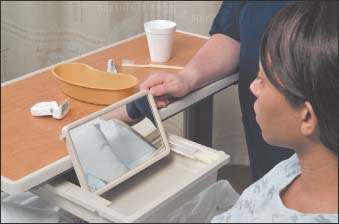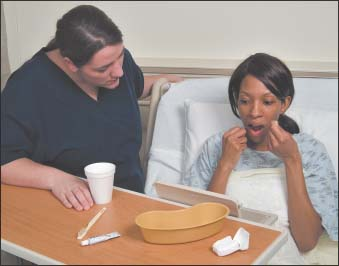Oral Care
Oral care, which typically involves the nurse or patient brushing and flossing the patient’s teeth and inspecting the mouth, is commonly performed in the morning, at bedtime, and after meals. Oral care removes soft plaque deposits and calculus from the teeth, cleans and massages the gums, reduces mouth odor, provides comfort, and reduces the risk of infection.
Patients who are intubated and receiving mechanical ventilation require oral care more frequently because mechanical ventilation dries the oral mucosa and affects salivary flow, increasing the risk for infection.1 Oral care should be performed every 2 to 4 hours in these patients. In 2010, the Institute for Healthcare Improvement added daily oral care with chlorhexidine to its ventilator-associated pneumonia (VAP) prevention bundle because evidence shows that it helps prevent VAP when combined with
the other bundle elements—elevating the head of the patient 30 to 45 degrees, interrupting sedation daily and assessing readiness to wean, and providing peptic ulcer disease and deep vein thrombosis prophylaxis, unless contraindicated.2
the other bundle elements—elevating the head of the patient 30 to 45 degrees, interrupting sedation daily and assessing readiness to wean, and providing peptic ulcer disease and deep vein thrombosis prophylaxis, unless contraindicated.2
Equipment
Towel ▪ facial tissues ▪ emesis basin ▪ trash bag ▪ mouthwash (preferably alcohol-free) ▪ toothbrush and toothpaste ▪ cup ▪ drinking straw ▪ dental floss or interdental cleaner ▪ gloves ▪ dental floss holder, if available ▪ small mirror, if necessary ▪ Optional: oral irrigating device.
For A Comatose or Debilitated Patient as Needed
Linen-saver pad ▪ bite block ▪ petroleum jelly ▪ oral suction equipment or gauze pads ▪ sponge-tipped swab ▪ Optional: mask, goggles, face shield.
For an Intubated Patient
Linen-saver pad ▪ bite block or oropharyngeal airway ▪ suction equipment ▪ petroleum jelly ▪ sponge-tipped swabs ▪ 1.5% hydrogen peroxide solution ▪ soft-bristle toothbrush ▪ toothpaste ▪ Optional: chlorhexidine mouth rinse.
Preparation of Equipment
Bring a cup of water and other equipment to the patient’s bedside. If you’ll be using oral suction equipment, connect the tubing to the suction canister and suction catheter, turn on the suction apparatus, and check for correct operation.
Implementation
Explain the procedure to the patient, and provide privacy.
Supervising Oral Care
For the bedridden patient capable of self-care, encourage her to perform her own mouth care.
If allowed, place the patient in Fowler’s position. Place the overbed table in front of the patient, and arrange the equipment on it. Open the table and set up the built-in mirror, if available, or position a small mirror on the table (as shown below).

Drape a towel over the patient’s chest to protect her gown. Instruct her to floss her teeth while looking into the mirror.
Observe the patient to make sure she’s flossing correctly, and correct her if necessary. If the patient is using dental floss, tell her to wrap the floss around the second or third fingers of both hands. Starting with her front teeth and without injuring the gums, she should insert the floss as far as possible into the space between each pair of teeth (as shown below). Then she should clean the surfaces of adjacent teeth by pulling the floss up and down against the side of each tooth. After the patient flosses a pair of teeth, remind her to use a clean 1″ (2.5-cm) section of floss for the next pair.

While the patient flosses, mix mouthwash and water in a glass, place a straw in the glass, and position the emesis basin nearby.
Instruct the patient to brush her teeth and gums while looking into the mirror. Encourage her to rinse frequently during brushing, and provide facial tissues for her to wipe her mouth.
Performing Oral Care
For a comatose patient or a conscious patient incapable of self-care, you’ll perform oral care. If the patient wears dentures, clean them thoroughly. (See Dealing with dentures, page 526.) Some patients may benefit from an oral irrigating device. (See Using an oral irrigating device, page 527.)
Arrange the equipment on the overbed table or bedside stand, including the oral suction equipment, if necessary. Turn on the apparatus. If a suction apparatus isn’t available, wipe the inside of the patient’s mouth frequently with a moist, sponge-tipped swab.
Mix mouthwash and water in a glass and place a straw in it.
Dealing with Dentures
Prostheses made of acrylic resins, vinyl composites, or both, dentures replace some or all of the patient’s natural teeth. Dentures require proper care to remove soft plaque deposits and calculus and to reduce mouth odor. Such care involves removing and rinsing dentures after meals, daily brushing and removal of tenacious deposits, and soaking in a commercial denture cleaner. Dentures must be removed from the comatose or presurgical patient to prevent possible airway obstruction.
Equipment and Preparation
Start by assembling the following equipment at the patient’s bedside:
Emesis basin
Labeled denture cup
Toothbrush or denture brush
Gloves
Toothpaste
Commercial denture cleaner
Paper towel
Sponge-tipped swab
Mouthwash (preferably alcohol-free)
Gauze
Optional: adhesive denture liner
Removing Dentures
To remove a full upper denture, grasp the front and palatal surfaces of the denture with your thumb and forefinger. Position the index finger of your opposite hand over the upper border of the denture and press to break the seal between denture and palate. Grasp the denture with gauze because saliva can make it slippery.
To remove a full lower denture, grasp the front and lingual surfaces of the denture with your thumb and index finger and gently lift up.
To remove partial dentures, first ask the patient or a caregiver how the prosthesis is retained and how to remove it. If the partial denture is held in place with clips or snaps, then exert equal pressure on the border of each side of the denture. Avoid lifting the clasps, which easily bend or break.
Stay updated, free articles. Join our Telegram channel

Full access? Get Clinical Tree


